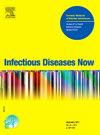支气管肺泡灌洗液中中性粒细胞与淋巴细胞的比值有助于COVID-19重症肺炎患者的个体化皮质类固醇治疗。
IF 2.2
4区 医学
Q2 INFECTIOUS DISEASES
引用次数: 0
摘要
目的:观察重症COVID-19患者支气管肺泡中性粒细胞与淋巴细胞比值(BAL-NLR)对大剂量皮质类固醇的反应。方法:回顾性分析2020年至2022年间入住重症监护病房的成人COVID-19肺炎患者的单中心队列,这些患者接受了支气管肺泡灌洗并接受了全身皮质类固醇治疗。我们将高剂量皮质类固醇治疗定义为至少1mg/kg/天的甲基强的松龙。结果:161例患者中,56例为低nlr (BAL-NLR(0.8-3.5)), 50例为高nlr(> -3.5)。四分之一的患者接受了大剂量皮质类固醇治疗。在HIGHBAL-NLR组中,接受高剂量皮质类固醇治疗的患者与接受标准剂量的患者相比,90天死亡率较低(27. %对43. %,p = 0.23)。在LOWBAL-NLR组中,接受高剂量皮质类固醇治疗的患者90天死亡率更高(31 % vs 12 %,p = 0.12)。结论:我们的研究结果表明,支气管肺泡细胞表型影响高剂量皮质类固醇治疗的治疗反应。本文章由计算机程序翻译,如有差异,请以英文原文为准。
The neutrophil-to-lymphocyte ratio in bronchoalveolar lavage fluid could help to personalize corticosteroid therapy in severe COVID-19 pneumonia
Objective
To investigate the response to high-dose corticosteroids according to bronchoalveolar neutrophil-to-lymphocyte ratio (BAL-NLR) in critically-ill COVID-19 patients.
Methods
We retrospectively analyzed a single-center cohort of adult COVID-19 patients admitted to the intensive care unit with COVID-19 pneumonia between 2020 and 2022, who had a bronchoalveolar lavage and received systemic corticosteroids. We defined high-dose corticosteroid therapy as the administration of at least 1 mg/kg/day of methylprednisolone.
Results
Among 161 patients, 56 had LOWBAL-NLR (<0.8), 55 MILDBAL-NLR (0.8–3.5), and 50 HIGHBAL-NLR (>3.5). A quarter of patients received high-dose corticosteroid therapy. In the HIGHBAL-NLR group, those receiving high-dose corticosteroid therapy had a lower (27 % versus 43 %, p = 0.23) 90-day mortality rate than those receiving a standard dose. In the LOWBAL-NLR group, those receiving high-dose corticosteroid therapy had a higher (31 % versus 12 %, p = 0.12) 90-day mortality rate.
Conclusion
Our results suggest that bronchoalveolar cellular phenotype influences therapeutic response to high-dose corticosteroid therapy.
求助全文
通过发布文献求助,成功后即可免费获取论文全文。
去求助
来源期刊

Infectious diseases now
Medicine-Infectious Diseases
CiteScore
7.10
自引率
2.90%
发文量
116
审稿时长
40 days
 求助内容:
求助内容: 应助结果提醒方式:
应助结果提醒方式:


